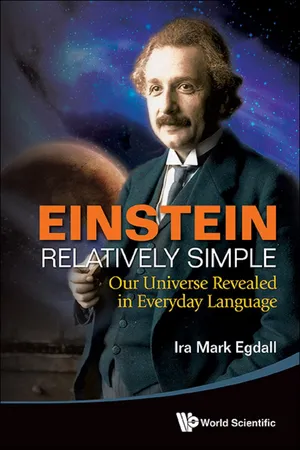![]()
PART I
Einstein Discovered:
Special Relativity, E = mc2,
and Spacetime
![]()
Chapter 1
From Unknown to Revolutionary
The most beautiful thing we can experience is the mysterious.
It is the source of all true art and all science.1
Albert Einstein
The year is 1905. Working alone at a Government Issue desk at the Swiss patent office on the corner of Grain Storage and Geneva Lane in Berne, a brash young man with a driving passion for physics is stuck. He has been wrestling with the problem off-and-on for nearly a decade.
His passion has become an obsession. He works on it in every spare moment at the patent office. He discusses the problem with his friend on walks home from work. His thoughts turn to it while in his small apartment with his wife, rocking his new son in his bassinet.
Then one fine day in May it comes to him. “I’ve completely solved the problem,” he tells his friend. “An analysis of the concept of time is my solution,” he declares over the clip-clop of horse-drawn buggies and rumble of new-fangled motor cars.2 With this insight, it all falls into place.
In that eureka moment on the streets of Berne, 26-year-old Albert Einstein altered our concept of reality forever. Einstein had begun the “relativity revolution” — a startling new vision on the nature of time and space.
It’s Relative!
Einstein’s strange new theory came to be called special relativity because it deals with the special case of motion called uniform motion.3 What is uniform motion? An object which travels at a constant speed and in a constant direction is in uniform motion.
Say you are in your car heading north at a speed of 60 miles an hour. As long as you don’t speed up or slow down or steer the car in another direction, your car is in uniform motion. (Since, in physics, velocity is defined as both speed and direction, uniform motion is also referred to as traveling at a constant velocity.)
Special relativity, however, said nothing about non-uniform motion, where speed or direction does change. Nor did it take into account the effects of gravity. Despite these limitations, Einstein showed the fundamental science accepted for centuries by physicists and lay people alike was wrong. Time and space are not absolute, they are not the same for everyone — they are relative.
What does this mean?4 Let’s take a look. Hold on to your hats — this is very strange:
Time is Relative
According to special relativity, clocks run slower when they move through space.5
Imagine you are attending one of my fascinating physics lectures. Hey, you in the back, wake up! Assume we are both wearing identical super-accurate watches. Say I walk across the front of the classroom at a steady pace — while you remain seated.
Per Einstein, you see my watch running a tiny bit slower than your watch. Why? Because I am moving with respect to you.
Now at the speed I am walking, this slowing of time is a very small effect — less than a billionth of a billionth of a second for each elapsed second. That’s why we don’t notice it. Nonetheless, it is a real effect.
The slowing of time becomes dramatic at speeds approaching the speed of light. Say I somehow speed by you at 87% the speed of light or about 580 million miles an hour. Because of my tremendous speed, you now see my watch running at only half the rate of your watch. That is, for every second that ticks off on your watch, only a half-second ticks off on mine. This is what you see and measure.
The next question is: what do I see? I see the exact opposite — I see your watch running slower than mine! As strange as this sounds, this is exactly what Einstein’s theory of special relativity predicts.
Whose point of view is correct? They both are. Time is relative. If your head is beginning to hurt, it means you are beginning to grasp the counter-intuitive ideas of relativity.
Per Einstein’s theory, space is also affected by motion:
Space is Relative
Say I now walk across the same room, this time holding up a pen in my hand pointed in my direction of motion. What do you see? You measure the length of my pen as shortened — because I am moving with respect to you. Per special relativity, the length of an object contracts along its direction of motion.6
This effect is also extremely tiny at walking speeds. That is why we don’t notice it. But if I were to somehow streak across the room at 87% the speed of light, then you would measure my pen compressed to half its length!
What do I see? Again, just the opposite. If you hold up a pen (oriented in the same direction), I measure your pen as shortened by half.
So if I am moving with respect to you, you measure my pen as shortened — and I measure your pen as shortened. Whose point of view is correct? They both are. Space is relative.
Why didn’t anyone notice these effects before Einstein? Because, as noted, they only become significant at so-called relativistic speeds — speeds which are an appreciable fraction of the speed of light.
Relativistic Speed
The speed of light is an incredible 670 million miles an hour (approximately). Per Einstein’s formula, we would have to travel at hundreds of millions of miles an hour to notice relativity effects. But we don’t experience anywhere near these speeds in everyday life. A commercial jet, for instance, travels at some 600 miles an hour relative to the ground, which is only about a millionth the speed of light.
So at everyday speeds, the effects of special relativity are simply too small to notice.7 But they are still real. As we shall see, all kinds of evidence — from atomic clocks on airplanes, rockets, and satellites to the measured lifetimes of subatomic particles and countless laboratory experiments — have borne out virtually all of Einstein’s incredible predictions.
What are we to conclude from over a century of evidence confirming the predictions of relativity? Albert Einstein’s strange universe is our universe!
To understand how Einstein came to develop special relativity, how a virtual unknown upstaged the most prominent physicists of his time; we first need to understand a little about the man himself, his early life experiences, his education both formal and informal, and most important — the formation of his character. Let’s take a brief look.
The Early Years
Albert Einstein was born on Friday, March 14, 1879 in Ulm, a small city on the banks of the Danube nestled in the German Bundesland of Baden-Württemberg bordering Bavaria. The Einstein family was amongst the 2% of the Ulm population of Jewish ancestry. However, neither parent was particularly religious.
His mother Pauline was the 21-year-old daughter of a well-to-do wholesale grain trader. His father, 32-year-old Hermann, prided himself on being a freethinker.8 He was, nonetheless, “exceedingly friendly and wise,” his son later recalled.9
The easygoing Hermann was an electrical engineer who showed “a marked inclination for mathematics”.10 Pauline, on the other hand, was an accomplished pianist noted for a rather strong personality. It appears that Albert got his technical abilities from his father and his extraordinary tenacity from his mother.
Reportedly, Albert did not speak until he was three years old. Then he exhibited an odd habit of whispering to himself. “Every sentence he uttered ... he repeated to himself softly,” recalled his younger sister Maja (Fig. 1.1).11 Because of this, the family maid labeled him “the dopy one.”
Einstein’s first encounter with science involved a pocket compass his father gave him. How, young Albert wondered, could the compass needle’s direction be influenced by an invisible source, by something in empty space? “This experience made a deep and lasting impression on me,” Einstein recalled.12 “Something deeply hidden has to be behind things.”
At age ten, his parents enrolled Albert in the prestigious Luitpold Gymnasium in Munich. It practiced a strict, formal, learning by rote method of instruction. Einstein hated it. He was a teacher’s nightmare — smart, arrogant, bored, and stubborn, with little respect for authority.13
Figure 1.1. Albert with his Sister Maja.
At age 12, led by what was to become a lifelong desire to find the unity in all things, Albert studied Judaism. He became quite religious for a brief time. But then Max Talmud, a poor Jewish medical student befriended by the family, introduced Albert to popular books in science as well as texts in mathematics and philosophy.14
“Through reading (about science), I soon reached the conviction that much in the stories of the Bible could not be true,” Albert concluded.15 “Suspicion against every kind of authority grew out of this experience, an attitude which has never left me.”16
At age 15, Einstein was expelled by the headmaster of the Gymnasium for disruptions in class and disrespect for teachers.17 A year later, without completing high school, Albert took entrance exams to a teachers college in Switzerland — the Swiss Federal Polytechnical Institute in Zurich. 18“Zurich Poly” (later the “ETH”) was considered one of the top schools for training mathematics and science teachers in Central Europe.
He failed in French, chemistry, and biology — subjects he did not care to learn — but did very well in mathematics and physics. Based on this, the principal of Zurich Poly arranged for Einstein to attend a small progressive non-denominational school in Aarau, Switzerland for additional instruction. Einstein (Fig. 1.2) then retook the Zurich Poly entrance exams and was accepted in the physics/mathematics program in 1896.
What was Albert’s reaction to now being in college? He complained his classes were old-fashioned — they didn’t even teach Maxwell’s equations, the relatively new theory uniting...

